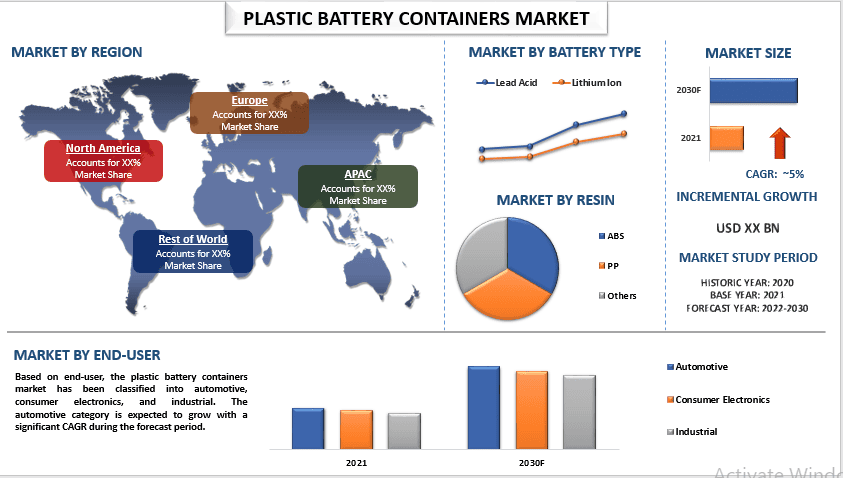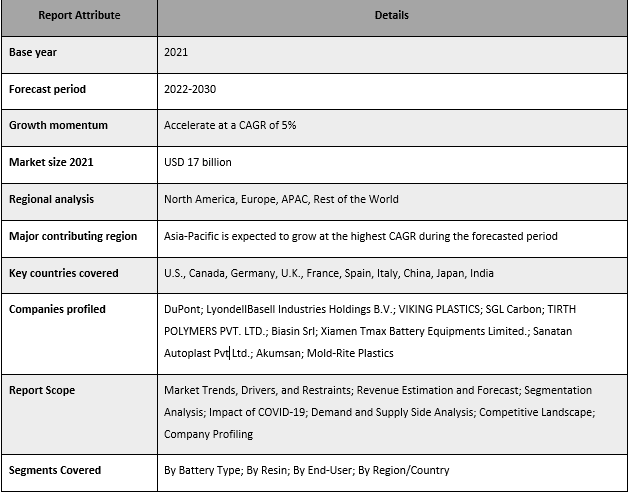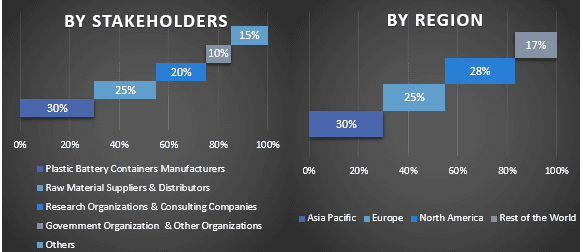- Accueil
- À propos de nous
- Industrie
- Services
- Lecture
- Contactez-nous
Marché des conteneurs de batterie en plastique : Analyse actuelle et prévisions (2022-2030)
Accent sur le type de batterie (plomb-acide et lithium-ion) ; résine (acrylonitrile butadiène styrène (ABS), polypropylène (PP) et autres) ; utilisateur final (automobile, électronique grand public et industriel) ; et région/pays

Le marché mondial des conteneurs de batteries en plastique était évalué à 17 milliards de dollars américains en 2021 et devrait croître à un TCAC de 5 % de 2022 à 2030. Un conteneur de batterie en plastique est défini comme un support de batterie en plastique moulé et idéalement encadré dans une construction unitaire unique. Les compartiments de batterie en plastique moulé comportent, de manière générale, des parties intérieures façonnées comme pièces basiques de la base et des parois latérales du support, et s’étendent sur toute la hauteur jusqu’au bord supérieur du support afin d’empêcher toute fuite de liquide entre les cellules voisines. Ces compartiments sont normalement façonnés sous forme de conceptions unitaires en une seule activité d’embellissement, la plupart des centres de forme définissant les trous intérieurs qui forment les parties. La forme est normalement orientée au centre de l’extrémité inférieure de chaque segment formant une dépression et les parois d’extrémité égales du compartiment. Par exemple, en avril 2021, Novel Materials a approché la conception de boîtier de batterie de véhicule électrique. Un boîtier de batterie doté d’un plateau composite monobloc renforcé de métal et d’un couvercle composite monobloc constitue un pas de plus vers une application de production de véhicule électrique (VE).
DuPont ; LyondellBasell Industries Holdings B.V. ; VIKING PLASTICS ; SGL Carbon ; TIRTH POLYMERS PVT. LTD. ; Biasin Srl ; Xiamen Tmax Battery Equipments Limited. ; Sanatan Autoplast Pvt Ltd. ; Akumsan ; Mold-Rite Plastics sont quelques-uns des principaux acteurs du marché. Plusieurs fusions et acquisitions ainsi que des partenariats ont été entrepris par ces acteurs afin de faciliter l’accès des clients à des produits/technologies de pointe et innovants.
Informations présentées dans le rapport
« Parmi les types de batteries, la catégorie lithium-ion devrait croître à un TCAC important au cours de la période de prévision »
Selon le type de batterie, le marché est divisé en batteries au plomb et lithium-ion. La catégorie lithium-ion devrait croître à un TCAC important au cours de la période de prévision. Cela est principalement dû à la demande croissante de lithium-ion dans diverses industries, telles que les télécommunications, l’aérospatiale, l’armée, l’automobile et l’électronique grand public. En outre, la demande croissante de lithium-ion est utilisée dans la fabrication de batteries de véhicules électriques. Par conséquent, les batteries lithium-ion sont utilisées dans plus d’une centaine d’applications automobiles, telles que les voitures hybrides et les voitures électriques. Ainsi, la demande croissante de véhicules a augmenté le nombre de production de batteries lithium-ion, ce qui a entraîné une augmentation de la valeur marchande des conteneurs de batteries en plastique.
« Parmi les résines, le polypropylène devrait croître à un TCAC important au cours de la période de prévision »
Sur la base de la résine, le marché est classé en acrylonitrile butadiène styrène (ABS), polypropylène (PP) et autres. Parmi ceux-ci, le polypropylène devrait croître à un TCAC important au cours de la période de prévision. Cela est principalement dû au fait que la plupart des compartiments de batteries automobiles et de leurs couvercles sont en polypropylène, car il offre un rapport solidité/poids élevé et une excellente résistance chimique. De plus, les supports en polypropylène peuvent être façonnés avec des parois et des parties minces, ce qui augmente le volume d’acide disponible et permet d’avoir des capacités plus élevées par rapport à des tailles données et à de nouvelles conceptions de batteries compactes. De plus, les boîtiers de batteries en polypropylène (PP) ont un taux de recyclage élevé.
« La région APAC devrait croître à un TCAC important au cours de la période de prévision »
En 2021, la région APAC devrait croître à un TCAC important au cours de la période de prévision. Cela est principalement dû à la prévalence croissante des véhicules électriques, soutenue par la croissance du revenu disponible et l’augmentation des dépenses par habitant des particuliers dans les économies émergentes de la région, ce qui stimule la croissance du marché. De plus, la demande croissante d’appareils portables et la présence de fabricants de premier plan devraient également soutenir la croissance du marché dans la région. En outre, les principaux acteurs du marché continuent d’ajouter davantage de produits afin d’accroître leur portefeuille d’activités. Par exemple, en septembre 2022, Amara Raja Batteries a proposé l’intégration en amont de l’activité de moulage de plastique. Le composant en plastique pour l’activité de batteries de MIL s’adresse exclusivement à ARBL, fournissant du plastique
Couverture du rapport sur le marché des conteneurs de batteries en plastique

Raisons d’acheter ce rapport :
- L’étude comprend une analyse de la taille du marché et des prévisions validée par des experts clés authentifiés du secteur.
- Le rapport passe brièvement en revue la performance globale de l’industrie en un coup d’œil.
- Le rapport couvre une analyse approfondie des principaux pairs de l’industrie en mettant l’accent sur les principaux aspects financiers de l’entreprise, les portefeuilles de produits, les stratégies d’expansion et les développements récents.
- Examen détaillé des moteurs, des contraintes, des principales tendances et des opportunités qui prévalent dans l’industrie.
- L’étude couvre de manière exhaustive le marché dans différents segments.
- Analyse approfondie au niveau régional de l’industrie.
Options de personnalisation :
Le marché mondial des conteneurs de batteries en plastique peut être davantage personnalisé selon les besoins ou tout autre segment de marché. En outre, UMI comprend que vous pouvez avoir vos propres besoins commerciaux, alors n’hésitez pas à nous contacter pour obtenir un rapport qui correspond parfaitement à vos exigences.
Table des matières
Méthodologie de recherche pour l'analyse du marché des conteneurs de batterie en plastique (2022-2030)
L'analyse du marché historique, l'estimation du marché actuel et la prévision du marché futur du marché mondial des conteneurs de batterie en plastique ont été les trois principales étapes entreprises pour créer et analyser l'adoption des conteneurs de batterie en plastique dans les principales régions du monde. Une recherche secondaire exhaustive a été menée pour collecter les chiffres du marché historique et estimer la taille du marché actuel. Deuxièmement, pour valider ces informations, de nombreuses constatations et hypothèses ont été prises en compte. De plus, des entretiens primaires exhaustifs ont également été menés avec des experts du secteur tout au long de la chaîne de valeur du marché mondial des conteneurs de batterie en plastique. Après l'hypothèse et la validation des chiffres du marché par le biais d'entretiens primaires, nous avons utilisé une approche descendante/ascendante pour prévoir la taille complète du marché. Par la suite, des méthodes de ventilation du marché et de triangulation des données ont été adoptées pour estimer et analyser la taille du marché des segments et sous-segments de l'industrie. La méthodologie détaillée est expliquée ci-dessous :
Analyse de la taille du marché historique
Étape 1 : Étude approfondie des sources secondaires :
Une étude secondaire détaillée a été menée pour obtenir la taille du marché historique du marché des conteneurs de batterie en plastique à partir de sources internes à l'entreprise telles que les rapports annuels et états financiers, présentations de performance, communiqués de presse, etc., et de sources externes, notamment les revues, actualités et articles, publications gouvernementales, publications des concurrents, rapports sectoriels, bases de données tierces et autres publications crédibles.
Étape 2 : Segmentation du marché :
Après avoir obtenu la taille du marché historique du marché des conteneurs de batterie en plastique, nous avons mené une analyse secondaire détaillée pour recueillir des informations sur le marché historique et partager les différents segments et sous-segments pour les principales régions. Les principaux segments inclus dans le rapport sont le type de batterie, la résine et l'utilisateur final. D'autres analyses au niveau des pays ont été menées pour évaluer l'adoption globale des modèles de test dans cette région.
Étape 3 : Analyse des facteurs :
Après avoir acquis la taille du marché historique des différents segments et sous-segments, nous avons mené une analyse des facteurs détaillée pour estimer la taille actuelle du marché des conteneurs de batterie en plastique. De plus, nous avons mené une analyse des facteurs en utilisant des variables dépendantes et indépendantes telles que les différents types de batteries, les résines et les utilisateurs finaux des conteneurs de batterie en plastique. Une analyse approfondie a été menée pour les scénarios de demande et d'offre en tenant compte des principaux partenariats, fusions et acquisitions, de l'expansion commerciale et des lancements de produits dans le secteur du marché des conteneurs de batterie en plastique à travers le monde.
Estimation et prévision de la taille du marché actuel
Taille actuelle du marché : sur la base des informations exploitables des 3 étapes ci-dessus, nous sommes parvenus à la taille actuelle du marché, aux principaux acteurs du marché mondial des conteneurs de batterie en plastique et aux parts de marché des segments. Toutes les parts de pourcentage requises et les ventilations du marché ont été déterminées à l'aide de l'approche secondaire susmentionnée et ont été vérifiées par le biais d'entretiens primaires.
Estimation et prévision : pour l'estimation et la prévision du marché, des pondérations ont été attribuées à différents facteurs, notamment les moteurs et les tendances, les contraintes et les opportunités offertes aux parties prenantes. Après avoir analysé ces facteurs, les techniques de prévision pertinentes, c'est-à-dire l'approche descendante/ascendante, ont été appliquées pour parvenir à la prévision du marché pour 2030 pour différents segments et sous-segments sur les principaux marchés à l'échelle mondiale. La méthodologie de recherche adoptée pour estimer la taille du marché comprend :
- La taille du marché de l'industrie, en termes de revenus (USD) et le taux d'adoption du marché des conteneurs de batterie en plastique sur les principaux marchés nationaux
- Toutes les parts de pourcentage, les divisions et les ventilations des segments et sous-segments de marché
- Les principaux acteurs du marché mondial des conteneurs de batterie en plastique en termes de produits proposés. De plus, les stratégies de croissance adoptées par ces acteurs pour être compétitifs sur le marché en pleine croissance
Validation de la taille et de la part du marché
Recherche primaire : des entretiens approfondis ont été menés avec les principaux leaders d'opinion (KOL), notamment les cadres supérieurs (CXO/VP, chef des ventes, chef du marketing, chef des opérations, chef régional, chef de pays, etc.) dans les principales régions. Les résultats de la recherche primaire ont ensuite été résumés et une analyse statistique a été effectuée pour prouver l'hypothèse énoncée. Les contributions de la recherche primaire ont été consolidées avec les résultats secondaires, transformant ainsi l'information en informations exploitables.
Répartition des participants primaires dans différentes régions

Ingénierie du marché
La technique de triangulation des données a été utilisée pour compléter l'estimation globale du marché et pour parvenir à des chiffres statistiques précis pour chaque segment et sous-segment du marché mondial des conteneurs de batterie en plastique. Les données ont été divisées en plusieurs segments et sous-segments après avoir étudié divers paramètres et tendances dans les domaines du type de batterie, de la résine et de l'utilisateur final sur le marché mondial des conteneurs de batterie en plastique.
L'objectif principal de l'étude du marché mondial des conteneurs de batterie en plastique
Les tendances actuelles et futures du marché mondial des conteneurs de batterie en plastique ont été mises en évidence dans l'étude. Les investisseurs peuvent obtenir des informations stratégiques pour fonder leur pouvoir discrétionnaire d'investissement sur l'analyse qualitative et quantitative effectuée dans l'étude. Les tendances actuelles et futures du marché ont déterminé l'attractivité globale du marché au niveau régional, offrant une plate-forme aux participants industriels pour exploiter le marché inexploité afin de bénéficier d'un avantage de premier arrivé. Les autres objectifs quantitatifs des études comprennent :
- Analyser la taille actuelle et prévue du marché des conteneurs de batterie en plastique en termes de valeur (USD). Analyser également la taille actuelle et prévue du marché des différents segments et sous-segments
- Les segments de l'étude comprennent les domaines du type de batterie, de la résine et de l'utilisateur final.
- Définir et analyser le cadre réglementaire pour les conteneurs de batterie en plastique
- Analyser la chaîne de valeur impliquée avec la présence de divers intermédiaires, ainsi qu'analyser les comportements des clients et des concurrents de l'industrie.
- Analyser la taille actuelle et prévue du marché des conteneurs de batterie en plastique pour la région principale.
- Les principaux pays des régions étudiées dans le rapport comprennent l'Asie-Pacifique, l'Europe, l'Amérique du Nord et le reste du monde.
- Profils d'entreprises du marché des conteneurs de batterie en plastique et stratégies de croissance adoptées par les acteurs du marché pour se maintenir sur le marché en pleine croissance
- Analyse approfondie au niveau régional de l'industrie
Connexes Rapports
Les clients qui ont acheté cet article ont également acheté










